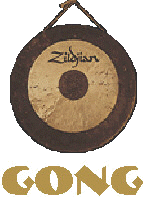Gong
Gong
Contents :
History
The gong is believed to have originated in the Middle East or Southeast Asia. The earliest form of the gong resembles the kettle gong because it was apparently flat.
The earliest mention of the gong was in China in the 6th century. They credited the introduction to 'barbarians' further west. The gong spread to Southeast Asia from China, reaching Java by the 9th century. From there it spread through Asia to Africa and eventually Europe.
The gong became established in Indonesia by the 9th century. They were made with deep, turned-down rims and have a raised knob in the center. These are generally called pot gongs.
These pot gongs are used in the Indonesian gamelan, or percussion orchestra. Usually they are of different sizes, each tuned to a different pitch. These gongs are made of bronze and have been in production for at least 1000 years, but possibly longer.
It appeared in Europe by at least the 18th century. A large, narrow rimmed gong of indefinite pitch was developed by the Chinese. It was this form of the gong that entered the Western orchestras in the 19th century.
Top
Description
The gong is a percussion instrument in the shape of a disk. It is made of hammered metal, sometimes bronze, but could be of copper and tin. It may be made in various sizes, having either definite or indefinite pitch. Many gongs have a central dome, but some are flat. Most also have a turned-down rim.
Orchestral gongs have a diameter of at least 3 feet. There are three different kinds used. The Burmese gong is made of thick metal and has a turned rim of 4 to 5 inches in height. The Chinese gong is made with a thinner metal and a smaller rim. The Turkish gong is made from cymbal metal.

Top
Sound Production
Sound is produced by striking the gong with a knobbed beater. The gong vibrates at the center.
